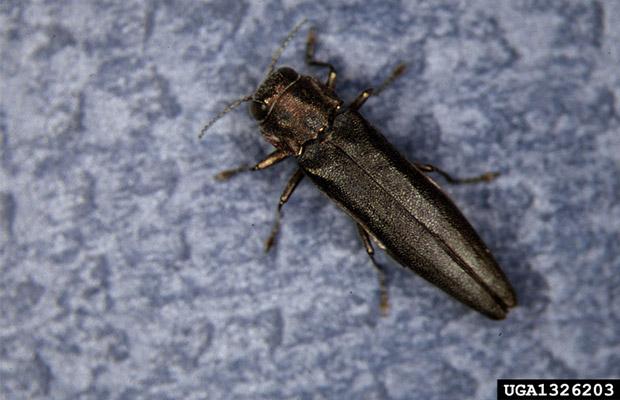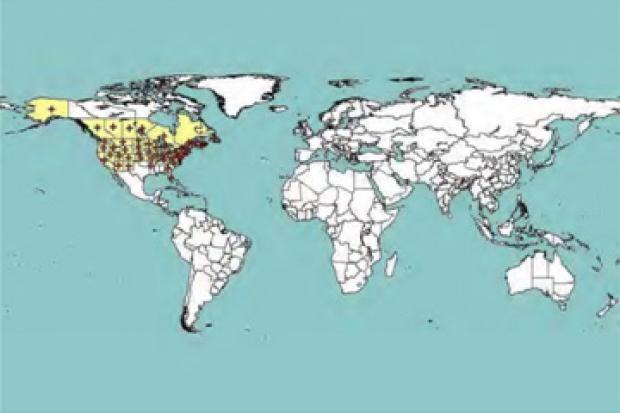Adults are small, narrow, metallic copper-coloured beetles 7-12mm long.
Threat

The species often attacks birch trees weakened by drought, old age, defoliation or soil compaction, although it also attacks healthy trees. The Bronze Birch Beetle is a quarantine pest for the EU, and is listed on the EPPO A1 list of quarantine pests with potential to cause extensive damage if introduced.
Northern Ireland Risk Register rating
| Organism | Hosts | NI Risk Rating |
|---|---|---|
| Agrilus anxius | Betula | 100 |
Susceptible species
In its native range, A. anxius is known to attack all native and introduced birch (Betula spp) species (and their numerous crosses) in North America. These include Betula alleghaniensis (yellow birch), B. jacquemontii (white-barked Himalayan birch), B. lenta (sweet birch), B. occidentalis (water birch), B. papyrifera (paper birch), B. pendula (silver or European birch), B. platyphylla (Manchurian birch), B. populifolia (gray birch), B. pubescens (downy birch), B. utilis (Himalayan birch). Although susceptibility varies between the birch species, it has been observed that the white-barked birches were generally more susceptible than those without white bark.
Spread
Adults can fly but there is only limited data on the natural spread of the insect. Over long distances, trade of infested trees and wood or wood products can ensure pest dispersal.
Outbreak stage and national plans
The bronze birch borer is absent from the UK. A UK Forestry Commission Contingency Plan has been developed which will guide the response to an outbreak.
Distribution
Agrilus anxius is native to North America (USA and Canada). It occurs throughout the range of birches in North America, and has been recorded in the areas indicated on the figure below.

Symptoms
Adults feed on leaves of Alnus, Betula and Populus but the damage tends to be insignificant. Significant damage is caused by larvae feeding on the inner bark and cambium of birch trees. Repeated attacks and the construction of numerous winding galleries by larvae disrupt nutrient transport that eventually kills the tree roots. Insect galleries can also girdle the birch tree branches and trunks. Initially symptoms of an infestation appear in the upper crown of the tree which exhibits leaf yellowing and branch dieback. Other evidence of an infestation is the presence of 5 mm wide ‘D’-shaped exit holes. Rust coloured sap oozing and staining can also be observed on the bark, along with swellings and bumps where the tree has healed inside. Tree mortality can occur within a few years after the appearance of the first symptoms.
Reporting suspect cases
If you think you have spotted the insect or insect damage, please check our symptoms section before reporting it using one of the Further Information contact points below.
Management, grants, treatment
In the EPPO region, birches are stand-forming tree species and are especially common in the British Isles, Northern Europe and Russia. With the exception of the Mediterranean region, they are widely planted for forestry and amenity purposes. For example in the Northern European countries, birches constitute a large part of the forest volume, ranging from 11.6 % in Sweden to 28.2 % in Latvia. In Scandinavian forests, the dominance of birch increases with latitude and altitude. Birch wood is also economically important for various building and industry purposes (e.g. plywood, pulpwood, furniture, birch sap).
In North America, the control of A. anxius mainly relies on preventive methods which favour birch growth (e.g. suitable planting sites, sufficient watering). Chemical control targeted at the adults during summer can be used in tree nurseries but is probably not practical in urban and forest environments.
Pest risk analysis
Following suggestions from the NPPO of Norway, where Betula spp. comprise up to 30% of the woodland cover, a PRA for A. anxius has been conducted by EPPO and the pest was added to EPPO A1 list and added to Annex 1 of EU Plant Health Directive.
Import & movement restrictions
Birch wood coming from the USA or Canada, where A. anxius is present, must be de-barked and have at least 2.5cm of sapwood removed or be treated with ionizing irradiation to achieve a minimum absorbed dose of 1 KGy throughout the wood. Wood chips, wood waste, scrap wood or similar material obtained in whole or in part from birch must be accompanied by an official statement confirming that it has originated from a country free of A. anxius, i.e. these materials, if they contain birch, cannot be imported from the USA or Canada. Isolated bark of birch must be free of wood.
Birch (Betula spp.) plants for planting must originate from a country known to be free of A. anxius, i.e. Betula species for planting cannot be imported from the USA and Canada.
Further information
Questions and answers
Contact:
Plant Health Inspection Branch
DAERA Northern Ireland:
Tel: 0300 200 7847
Email: planthealth@daera-ni.gov.uk
